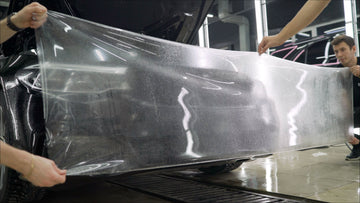
Every time you drive, your car’s paint is under attack. Road debris, rock chips, bird droppings, UV rays, and bug splatter all come together and degrade your paint over time. Once the damage is done, fixing it isn’t cheap—repainting a car or even a single panel can cost thousands, and color matching is never perfect. This is why Paint Protection Film (PPF) has become one of the most effective ways to safeguard your car’s exterior.
But what exactly is PPF? How does it work, and is it really worth the investment? This guide will break down everything you need to know about paint protection film, from how it functions to what you should look for in a high-quality installation.
What is Paint Protection Film?
Paint Protection Film, commonly referred to as PPF or clear bra, is a thin, transparent polyurethane film applied to a vehicle’s exterior surfaces to shield the paint from damage. Originally developed for military applications to protect helicopter blades from debris, PPF has evolved into a high-tech protective solution for cars, motorcycles, and even boats.
At its core, PPF acts as an invisible shield, absorbing impacts and preventing scratches, stains, and chemical damage from reaching the paint beneath. Unlike traditional wax or ceramic coatings, which only provide a hydrophobic barrier, PPF offers actual physical protection against road debris and minor abrasions.
How Does PPF Work?
Modern paint protection films are engineered with multiple layers, each serving a unique purpose. The most advanced PPFs typically consist of three key layers:
-
Top Coat: A self-healing, stain-resistant layer that repels contaminants and minimizes swirl marks. Some premium PPFs also feature a hydrophobic coating that enhances water repellency.
-
Polyurethane Core: The impact-absorbing middle layer that protects against rock chips, scratches, and other physical damage.
-
Adhesive Layer: A strong yet flexible adhesive that bonds the film to the paint without damaging it, ensuring easy removal when needed.
Self-Healing Technology
One of the most impressive advancements in modern PPF is self-healing technology. Minor scratches and swirl marks disappear with heat exposure—whether from the sun, a heat gun, or warm water. This keeps the film looking pristine and ensures your car maintains a flawless finish over time.
Hydrophobic Properties
Many high-end PPFs now include hydrophobic top coats, which help repel water, dirt, and grime. This means your car stays cleaner for longer and is easier to wash, similar to what you’d get with a ceramic coating but with added physical protection.
Why Does PPF Matter?
1. Paint Damage is Unavoidable
Unless you plan to park your car in a garage and never drive it, your paint will suffer damage over time. Rock chips from highway driving, sandblasting from road salt, acid etching from bird droppings, and discoloration from UV rays all contribute to long-term deterioration.
2. PPF vs. Other Protection Methods
Many car owners wonder whether they should choose PPF, ceramic coatings, or traditional waxes and sealants. Here’s how they compare:
-
PPF vs. Ceramic Coating: Ceramic coatings create a slick, hydrophobic surface but do not physically protect against rock chips or scratches. PPF provides both impact resistance and hydrophobic properties (if top-coated).
-
PPF vs. Wax/Sealant: Waxes and sealants offer temporary protection but need constant reapplication and provide no physical defense against road debris.
3. Protecting Your Investment
Your car is one of the biggest purchases you’ll ever make. Whether you own a daily driver, a high-performance sports car, or a luxury SUV, preserving the factory paint enhances resale value. A car with pristine, protected paint will always command a higher price than one covered in rock chips and swirl marks.
4. Long-Term Cost Savings
Repainting a car or fixing deep scratches can cost thousands of dollars. With PPF, you’re investing in preventative protection, which can ultimately save you money by avoiding costly repairs down the line.
Where Should You Apply PPF?
While some car owners opt for full-body PPF, many choose to protect only the most vulnerable areas. The most common high-impact zones include:
-
Front bumper – The most exposed area for rock chips.
-
Hood – Prevents damage from debris kicked up by other vehicles.
-
Side mirrors – Often hit by road debris and bugs.
-
Door edges and handles – Protects against scratches from rings, keys, and fingernails.
-
Rocker panels – Essential for off-road or performance vehicles that kick up debris.
For those who drive frequently on highways or in harsh climates, full-body PPF provides the ultimate protection against sun damage, road salt, and debris impact.
What to Look for in a PPF Installation
Not all PPF installations are created equal. Here are some key factors to ensure you’re getting a high-quality install:
1. Proper Surface Preparation
PPF must be applied to a clean, defect-free surface. If there are contaminants, swirl marks, or scratches on the paint, they will be trapped under the film. Many reputable installers perform a light paint correction before application.
2. Edge Wrapping & Seamless Installation
A quality installer will wrap edges wherever possible, ensuring minimal visible film lines. Poorly applied PPF with exposed edges is more likely to lift over time and collect dirt.
3. Choosing High-Quality Film
Not all PPFs are equal. Cheaper films yellow, crack, or fail prematurely. Leading brands offer high clarity, durability, and long warranties. Do your research before choosing an installer.
4. Warranty & Reputation
Top PPF brands offer warranties ranging from 5 to 10 years, but a warranty is only as good as the company backing it. Always choose an installer with a strong reputation and proven experience.
PPF is a Smart Choice for Any Vehicle
PPF is one of the best investments you can make to preserve your car’s paint and maintain its value. It offers unmatched protection against rock chips, scratches, and environmental damage that waxes and ceramic coatings simply cannot provide.
However, not all PPF is the same, and a poor installation can ruin the experience. Choosing a high-quality film and an experienced installer is just as important as deciding to get PPF in the first place.
If you’re considering PPF for your car, take the time to research film options, installation techniques, and trusted professionals. The right PPF can keep your vehicle looking brand new for years to come.
